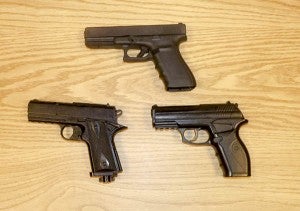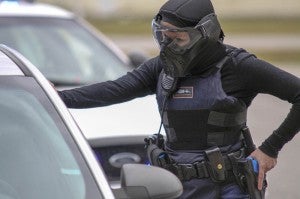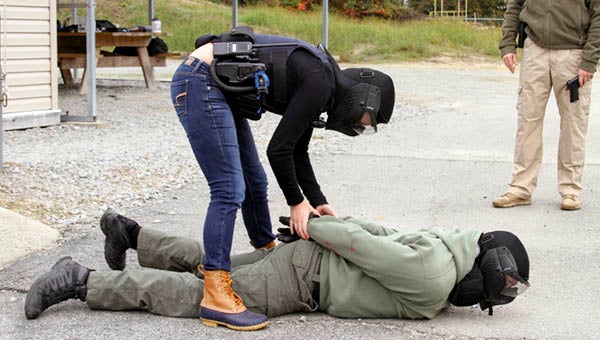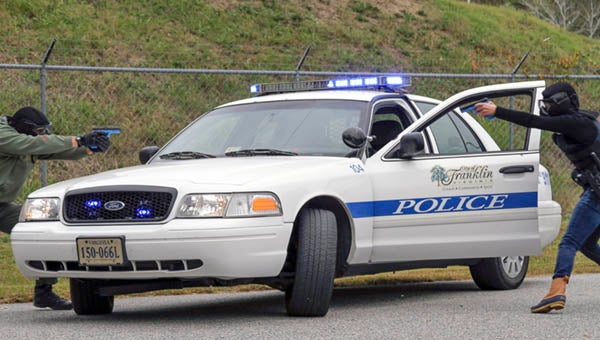Behind the badge: Part II
Published 11:29 am Wednesday, November 18, 2015
Editor’s Note: This is the second article in a series of stories intended to give readers an exclusive inside look at the professional lives of Franklin police officers.
FRANKLIN
Force-on-Force training is an exercise that the Franklin police officers go through on a regular basis to practice use of force.
The men and women are put in different scenarios that depict real-life crimes which have happened or scenarios involving actions and crimes likely to happen. Trainers play the roles of suspects and the other officers act as if they are responding to a call.

The gun on top is the kind that the Franklin police officers carry around with them on a daily basis. The guns on the bottom are ones that the officers have taken from suspects that have proved to be fake. — Rebecca Chappell| Tidewater News
Of course the training doesn’t use the real weapons that police officers carry around with them on a daily basis. For example, the guns use paintballs instead of real ammunition. Also a real Taser, or pepper spray are not used; trainees instead mimic the action of using them.
The training takes place behind the airport in Franklin where they are able to set up and layout different scenes. The lot has buildings, roads and more to make the scenes seem as real as possible.
Although there are general scripts written out for the different scenarios, the trainers switch on and off with being suspects that comply and suspects that don’t. This helps the officers practice making decisions regarding the appropriate time and kind of force to use, as well as the appropriate way to handle non-compliant suspects.
During a recent training, I played the role of a police officer responding to calls. I put on all the gear, such as a vest, a mask and the belt that had all the weapons on it. I then practiced using the gun. A member of the Franklin Police Department would drive up to each training scene and I would ride in the passenger seat. After we got there, I would walk around to the driver’s side door and then the scenarios would begin.

Rebecca Chappell of The Tidewater News talking to the person she had pretended to pull over during one of the scenarios in the Force-on-Force training she participated in. — Sgt. Brent Gayle | Franklin Police Department
The first scene was about to start. The call came over the radio and said something along the lines of, “There’s a man pacing, walking around with an object in his hand.”
That was all that came over the radio besides the description of the man and the address before pulling up.
The lights went on and the car pulled around the corner. There the man was, pacing around the cul-de-sac holding something. I got out of the car and started walking toward him — asking who he was, what was wrong, what I could do to help and any other question I could think of to get some information out of him.
The closer I got, I realized the object was a knife. I then asked him to put it down and so I could help him.
He kept pacing and shouting, “Why should I tell you anything? You don’t care about me, nobody does. I’m just going to end my life!”
I asked him to put the knife down, but he was still shouting; I couldn’t find a way to reason with him.

Chappell handcuffs a suspect during an exercise that was part of the Force-on-Force training she participated in with the Franklin Police Department. — Andrew Lind | Tidewater News
Before I knew it, he was running after me with a knife and stabbed me in the neck. I was laid out on the ground bleeding to death. The scenario was over and I was dead.
Sometimes police officers have no way of being able to reason with a suspect and they have to protect themselves if the person isn’t going to listen and they are trying to hurt them.
“It doesn’t matter how many times we try to explain it, there are times when the agitation and the frustration is so high that they aren’t going to hear it. And you leave there knowing that sooner or later I’m going to have to come back there again because we see them daily,” Cpl. Josh Butts said. “Whether it’s northside or southside in the city, it doesn’t make a difference; you’re going to see that person again. You want to do your job and go home to your family. Nobody in this agency has the desire to go out and hurt anybody. There is a perception and misconception that stems from national attention that we do.”
The next two scenarios showed what can happen when a suspect fails to comply.
The first one involved a man who had stolen a case of beer from Walmart and had fled to Applebee’s. During this scene we pretended that a shed was Applebee’s. The description that came over the radio was a man who was wearing all green.
During this scenario I had a partner; we pulled up to the fake Applebee’s and walked in. We asked the owner if they had seen the man and he said he was in the bathroom.
We walked in the bathroom and there he was. He gave us a lot of attitude and kept facing away from us. I noticed he kept moving his hoodie around, as if he was trying to hide something under there.
The suspect told us he had drank all of the beer, so he was asked to step outside. After some arguing, he finally agreed to.
We got outside and he pulled a gun out from the front of his pants and aimed it at me.
I reached for my gun, but I was too slow. My partner, however, wasn’t slow and shot the suspect.
After the suspect was on the ground, I called an ambulance and walked up to him to cuff him. Then I noticed the gun he pulled on me was a fake. I looked at it and I looked at mine, they looked exactly the same.
If the suspect had complied, then he would have never been shot.
The second situation involved checking radar. The police car was parked and they had a training officer drive by going 12 miles over the speed limit. The blue lights came on and pulled him over. I got out of the car, but before I could head toward his vehicle, he got out of his and faced away from me.
He was yelling at me but still not looking at me. I stood behind the door because I noticed that he had a gun in his hand. I used the door to put a shield between the suspect and myself. I didn’t know all the force rules at that time so I asked him to put the gun down, but what I should have done was automatically pull my weapon.
He turned around and started shooting at me. I ducked, grabbed my gun and started shooting back. Next thing I knew, we were running around the police car shooting back and forth.
I got shot in the hand, but I kept going because police officers want to walk away from the scene alive. I finally shot him down and it was over.
“When they fail to comply and it’s a time when there is probable cause to make an arrest and we have to make an arrest or we have to detain someone, then we end up using force — justified force — to resolve that situation,” Sgt. Todd Lyons said. “And typically speaking, when we begin to use force, it’s a possibility that people get injured. And so that bottom line is if people would just comply with what we’re asking them to do, there is an appropriate forum available whether it be a court of law, whether it be through an official complaint process, to deal with your grievance for whatever the police officer is doing. But here on the side of the road is not the time to hear your grievance.”
The last scenario started and again I was checking radar. The police car was parked and the training officer drove another car 12 miles over the speed limit by the police car that I was in.
The car then got pulled over and when I got out of the car, the suspect didn’t. I walked up to the car and knocked on the window. This time all I got was hostility from the suspect. The man wouldn’t cooperate with me. He wouldn’t hand me his driver’s license and registration. He was yelling, complaining and calling me every bad name in the book.
I gave him a warning, he still didn’t comply. I tried and opened his door, but he wouldn’t let me.
He asked for my supervisor, so I called him. The supervisor appeared.
He finally got the man to put his driver’s license and registration up through the window. I got the information and wrote him a ticket.
Use of force and learning to stay professional go hand in hand when a suspect isn’t complying with police officers.
Cpl. Chris Thomas said, “You have to have serious patience. Sometimes it’s just like dealing with kids.”
Butts said, “If young officers are honest and older officers are honest, when you first get into this job you think that you’re superman and you have control over every situation. If you’re smart, you will learn very quickly that you don’t and for some it’s harder to learn that. But over time, and as it comes with learning this job and learning how to interact with people, you learn how to stay professional.”
The training made a couple of things obvious – aspects to the profession that not everybody necessarily thinks about.
Police officers have no idea what they are walking into or how everything is going to play out when they pull up to a crime scene. They also have no idea if they are going to away in the same shape as when they got there, or if they are going to be able to walk away at all. When suspects don’t comply, that’s when the use of force is required. It’s hard to get the situation under control when a suspect is fighting you. That’s how people get hurt, that’s how lawsuits get filed and that’s when officers are unable to do their job.
Some officers feel that if residents understood the laws more, then there would be more compliance and less hostility.
Lyons said, “I think a lot of that misconception revolves around the fact that people don’t understand the judicial system in this country. My job isn’t to determine innocence or guilt, my job is to find probable cause if a crime has been committed and bring that before the court. A lot of folks get to berating you and giving you a hard time because they are trying to try their case on the side of the road. My job is to find if there is probable cause and bring that arrest before the courts. And a court of law is where it’s time to argue.”
The next article in this series will be in Friday’s edition. In that story, you will get to read a first-hand account of what police officers experience on a regular basis during the day in the streets of Franklin.






